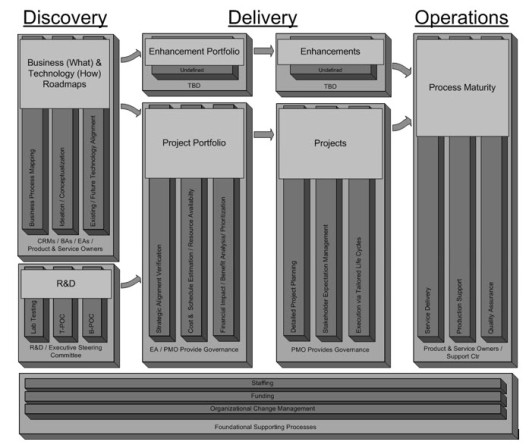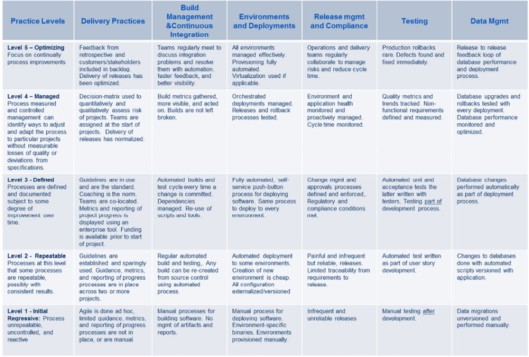In a previous post I wrote about Step 1: Agile Transformation readiness. In this post, I will describe Step 2: Agile Deployment.
The goal of the Deployment Phase is to execute the agile approach and practices and help the team apply them to the pilot project. In Step 1, you created the agile methodology as part of your readiness strategy; in this step, you are now deploying it to a pilot team where they can begin using it. As part of your deployment process, ensure that the team is taught the new process and that there is a point-of-contact team members can engage to ask questions and resolve issues. Some would say this is the Agile Project Manager’s job, and they are right, except. However, when using a new process, it is wise to team the Agile Project Manager with a seasoned Agile Project Manager, who has led agile transformations before. This person must be able to communicate up and down the organizational hierarchy; talk effectively with the project managers, developers, testers, and managers; and demonstrate servant leadership and the Whole Team® philosophy. The Agile Project Manager, identified in Step One is typically that point-of-contact.
Deployment involves collaborating with stakeholders to carry out the following:
- Set up the agile planning tool. Excel can be used for the pilot, but as agile is scaled, it is recommended an enterprise agile project management software tool be purchased and used.
- Provide agile training. Do not underestimate the need for formal and informal training. It is recommended that the Agile Project Manager teach not only the science but the art of agile. Demonstration is an effective teaching tool, as people often learn best when observing others. Informal training is the coaching the Agile Project Manager provides while observing others in their day-to-day work environment.
- Deploy the agile methodology and practices. This is the methodology developed in Step One.
- Hold periodic meetings to ensure deployment is on track and directionally correct. It is strongly recommended that upper management be consulted on a regular basis so they know how the agile project team is progressing. Regular reporting can remove organizational impediments. Twice weekly meetings with the Agile Project Manager and a PMO lead can mitigate any misunderstandings, aid in needed course corrections, and just-in-time continuous improvement activities can be implemented quickly.
In many organizations that are implementing agile, tools are already being used for estimating and tracking progress. The purpose of this activity is to begin standardizing the tool-set and make sure the agile project teams are consistently using the same tools as they perform their work. In one company for which I consulted, the software development team stated they were using agile. The approved agile and collaborative tool suite consisted of:
- A whiteboard
- A Microsoft Excel™ spreadsheet
- Microsoft Lync™ or LiveMeeting™
- Microsoft Outlook™
- Microsoft Word™
- Mind Mapper™
- Jira Greenhopper™
- TitanPad™
Only the whiteboard and Microsoft Excel™ were being used, albeit sparingly and not effectively. The agile methodology developed in Step 1, instructed the pilot team to use Microsoft Excel™ and place a sprint burn-down chart on the white board, updated daily by the Agile Project Manager. The agile methodology also instructed the Agile Analyst (AA) to use Microsoft Excel™ as a product backlog, and a user story process was developed to aid in the management of the all the user stories. Now, some would argue the AA role should not be on an agile team; however, I have been in companies where the AA role is a specialized and entrenched role in the organization. Convincing the PMO management, that a team of software developers and testers will own requirements for an agile project will lead to a political battle that will doom your agile transformation. One strategy to use is to take what the IT department gives you and work with the roles (business analyst, project manager, developer, tester, architect, etc.) that are available and transform them into a true servants to each other.. Once they become more disciplined and the processes are intuitive, the team begins to perform and the Agile Project Manager will see the individual roles disappear and the agile team’s success will pave the way to open conversations about evolving the institutional roles to that or more agile-centric roles on an agile project ..
Providing agile training is not as simple as merely sending employees to agile classes. It involves much more. The employee should be taught the agile methodology that was agreed to and developed by the company in which he/she works for and the stakeholders have approved in Step One. Agile team members should be encouraged to use and increase their competence in the agile methodology. Only when they can prove competence and maturity in using the agile methodology should they be able to improve the methodology by bringing in new concepts. Some agile purists may not agree with that philosophy, but this author stands behind the notion that just because a person has been taught a “process” does not mean that person can successfully and consistently apply that process. The agile project team must be allowed to develop as a team, as the Tuckman Model suggests (Tuckman, 2012).
On the topic of software tools, the tools available in the industry are too numerous to count. I am not recommending one tool over another. But what I am recommending is that there is an agreed upon set of software tools that agile project teams can use; that their use is monitored; and that continuous improvement of those tools is performed at regular intervals. Also, if an enterprise agile software tool is used, metrics should be captured to aid and give visibility to project team members and management. As long as the enterprise agile software tools add value to the agile project team and the creation of the new software product, use of any tool should be evaluated and agreed on for use by the agile project team.
I strongly recommend using the following process when selecting an agile enterprise software tool: Focus on People, Process, and Tools. Step 1 focuses on the People; steps 2 and 3 focus on the Process; only at step 4 should you have the conversation around tools.
People. The initial focus must be on people. The pilot team has to mature to a point where it can effectively use any agile software tools. I was leading the agile transformation of a young agile team that introduced an enterprise agile tool too early in the transformation. It created anarchy! I removed the use of the tool from the pilot team and we went to using a whiteboard and Microsoft Excel. The pilot team could not use those tools effectively. I realized that training was needed and sent the pilot team members to formal agile training and informal agile training on the new agile methodology. At the end of one release, the team had knocked off two weeks from their delivery cycle and during the retrospective, expressed excitement in planning out the release and sprints and seeing the iteration burn-down charts. What was interesting was what they listed for improvement in the upcoming release: that the Agile Project Manager stops asking them for their completed work that day; he was reminding them of a traditional project manager, command and control. At that point, they recognized the need for an enterprise agile software tool, where they can input their daily status and time and the Agile Project Manager can use it to ascertain project status and progress. Since they accepted ownership of each task, they also accepted the responsibility for reporting work on a task. The enterprise agile software tool was reintroduced to the team and they used it without hesitation. What was learned was three-fold: one, focus on the people aspect of agile transformation; two, ensure the pilot project team members are trained on the new agile methodology; and three, let the team develop and solve their own problems. As the leader of the transformation, you can fall into the trap of telling the team what to use (the tool) instead of asking the team what they need (servant leadership) and supporting them in their progression toward agility.
Process. Once the pilot project team has been trained and a pilot project has been selected, deploy the agile methodology and practices to the team and monitor progress. This can be performed by the Agile Project Manager. This is where organization change management concepts can be leveraged. Organizational change is defined as a difference in form, quality, or state over time in an organizational entity (Van de Ven & Poole, 1995, p.512). The entity may be an individual’s job, a work group, an organizational sub-unit, the overall organization, or its relationships with other organizations. In this case, it is the new agile methodology. Change can be measured by observing the agile methodology over two or more points in time on a set of characteristics and then observing the differences in these characteristics over time. If the difference is noticeable, we can say that the organizational entity has changed (Van de Ven & Sun, 2011). Much of the voluminous literature on organizational change focuses on two questions about this difference:
1) How and what produced it?
2) How might it be managed in sustainable and constructive directions over time?
Question 1 will be addressed in Chapter 10. Question 2 is answered in the following context: when a new process is introduced to employees, they tend to have problems implementing it and always have questions. The Agile Project Manager can be leveraged as the point-of-contact to answer those questions and model the use of certain agile techniques and principles. There should be an agile transformation governance team consisting of the person funding the transformation in addition to senior members of the transformation pilot project. The primary purposes of this governance team is to collect feedback on the use of the agile methodology; make suggestions for changes to the methodology; and communicate with middle- and upper management on the agile transformation’s progress.
This leads us to holding periodic meetings to ensure deployment is on track and directionally correct. Ensuring you have an executive champion will not guarantee that an agile transformation will be successful, but can increase the odds. While leading an agile transformation, you must keep the executive sponsor and his orher stakeholders informed of progress, challenges, risks, and successes. It is also recommended that you spend real dollars instead of implementing an agile transformation off the side of your desk. More attention is given to projects by executives where real capital dollars are being spent than to projects using “invisible” expense dollars. This will also give you and your transformation team the support it needs to remove constraints, obstacles, and issues that can consume your agile transformation initiative if left unattended.
Tools. Lastly, enterprise tools should then be introduced to the agile project team after the Agile Project Manager has address the People and Processes part of the triangle. Agile software tools can be an effective and efficient way to collect metrics, proactively anticipate risks, and provide just-in-time access for upper management on how the pilot project is progressing.


